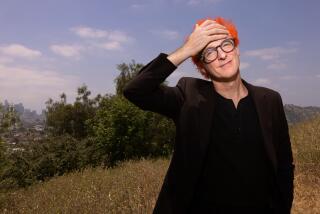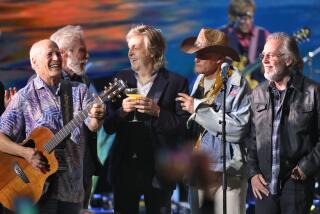Hit Makers of the ‘50s Keep on Ticking
- Share via
LARGO, Fla. — Nearly half a century after “Rock Around the Clock” helped give birth to rock ‘n’ roll, original band members from Bill Haley and His Comets are still rockin’.
The musicians, now in their 60s and 70s, may be slowed by age, but these retirees still have the beat, occasionally touring around the world.
“We were the band that created the sound,” says Marshall Lytle, at 67 the youngest of the group known as the Original Comets. “When people say, ‘You sound just like Bill Haley’s Comets,’ I say, ‘That’s who we are.’ ”
Lytle, on bass, still does his signature high-energy performance of the mid-1950s. He jumps and stands on the 20-pound fiddle and hurls it into the air during concerts.
Today, he owns a home decor shop with his wife, Jeanne, in Largo, near Tampa, and gets together with his bandmates for concert tours in the United States and Europe several times a year.
His desk in a corner of the store is like a shrine to rock ‘n’ roll. On the wall, there are gold records and signed photographs of the group, then and now. There’s also an orange banner reading “You’re never too old to rock,” and a copy of a 1955 flier from a Tulsa, Okla., concert that has Haley and the Comets headlining--and Elvis Presley as just another act.
It doesn’t take much coaxing to get Lytle to break into song and start snapping his fingers and tapping his feet.
“Rock ‘n’ roll is the fountain of youth,” says 77-year-old drummer Dick Richards of Ocean City, N.J. “You get on stage, see all those people out there, it makes you 18, 19 years old again. I don’t know anything that can beat that high.”
Lytle, Richards, sax player Joey Ambrose, 67, of Las Vegas, and keyboardist Johnny Grande, 71, of Nashville, all were members of Haley’s band when they recorded “Rock Around the Clock.” The 1954 recording went on to become the anthem of rock ‘n’ roll.
They make up the Original Comets, along with guitarist Franny Beecher, 79, of Norristown, Pa. Beecher, who played with Benny Goodman’s swing band in the late 1940s, joined Haley in 1954 as lead electric guitar after the untimely death of original guitarist Danny Cedrone.
“My reward for recording ‘Rock Around the Clock’ was $41.25. That was the musician’s scale for a three-hour recording session then,” Lytle says.
The band had rehearsed “Rock Around the Clock” in Haley’s basement. When they got to the studio, the producer pushed “Thirteen Women” as the A side of the Decca record. Haley and His Comets spent 2 1/2 hours on that song. They had to do the arrangement first, then the recording.
With only a half-hour left on the schedule, they recorded “Rock Around the Clock” as the B side in two quick takes.
“It didn’t take off right away,” Lytle says. “The record was put out promoting ‘Thirteen Women.’ ”
“Shake, Rattle and Roll,” recorded at a second session, became a hit first.
In 1955, “Rock Around the Clock” was picked as the title track for the teen rebel movie “Blackboard Jungle” after a producer heard the song blaring from his teenage daughter’s bedroom.
“It became an instant worldwide hit,” Lytle says.
It shot to No. 1 on the charts, stayed for eight weeks and sold 22 million copies.
Bill Haley and His Comets were in demand to play ballrooms, arenas and concert stages worldwide. Fans mobbed them everywhere, once trashing the stage in Berlin and forcing them to an armory rooftop for safety.
They appeared on Milton Berle’s television show, “The Ed Sullivan Show” and “American Bandstand.”
Lytle gives much of the credit for success to the late James Myers, co-author of the song with Max C. Freedman. Myers, who owned a publishing company, never missed a chance to promote the song, for which he received handsome royalties. He got the song into 40 movies--and his Mercedes. When Myers tooted the horn on his car, it played “Rock Around the Clock.”
Haley died in 1981.
Lytle, Richards and Ambrose had quit the band in 1955 to form the Jodimars, a name they made up using a combination of letters from their first names.
“We thought we could really knock them dead,” Ambrose says. “We never really had a hit, but we did OK.”
Grande and Beecher stayed with Haley until 1962. In the late 1950s, the sound and style changed as Elvis climbed the charts, then changed again as the Beatles exploded onto the music scene.
Eventually, all the original band members went their separate ways, getting jobs to support their families, some continuing to play weekends for the love of the music.
In 1987, they were asked to come to Philadelphia for a reunion of acts that had performed on “American Bandstand.”
“We hadn’t seen each other in over 30 years. We walked right by each other in the hotel,” Ambrose says. “We got together and rehearsed till we got it down good enough that we wouldn’t make a fool of ourselves. And we got a standing ovation.”
Beecher says he was all for the reunion, which they all figured would be “a one-time thing.”
“We didn’t intend to make a career of it,” he says.
Since then the group has been back on tour playing festivals, fairs and concerts in Europe and the United States, with Londoner Jacko Buddin singing--he sounds a lot like Haley.
This time the retirees say it’s not a whirlwind pace. They get to choose when and where they go.
“I’m asked if I ever think of giving it up,” Beecher says.
“To do what--sit in a rocking chair? This is not like working everyday. It’s more like a vacation.”
More to Read
The biggest entertainment stories
Get our big stories about Hollywood, film, television, music, arts, culture and more right in your inbox as soon as they publish.
You may occasionally receive promotional content from the Los Angeles Times.










